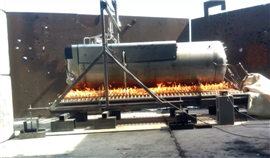Read this article in Français Deutsch Italiano Português Español
SAG Group bets on liquid hydrogen with innovative fuel tank design
11 March 2025
Austria’s SAG Group specializes in making lightweight components for automotive, commercial vehicle and rail applications around the world. Among those products are fuel and urea tank systems for heavy-duty commercial vehicles. These include cryogenic storage tanks for fuels such as liquefied natural gas (LNG) and liquid hydrogen (LH2).
The company’s LH2 tank is among its latest developments. In a 2023 press release, SAG described the tank’s construction. Made of stainless steel, the LH2 tank is double-walled and vacuum-insulated with a special valve system designed for the extremely low temperatures associated with LH2 (-253°C, -423ºF).
 Adding fuel to the SAG Group’s LH2 tank on the #HydrogenRecordRun truck. (Photo: Daimler Truck)
Adding fuel to the SAG Group’s LH2 tank on the #HydrogenRecordRun truck. (Photo: Daimler Truck)
Setting a Record
SAG’s tank showed initial promise in September 2023 as part of Daimler Truck’s #HydrogenRecordRun. That’s when Daimler’s GenH2 fuel cell electric truck covered a record-setting distance of 1,047 km (651 miles) with a 40-tonne payload on a single fill of liquid hydrogen, both companies reported. Daimler said the truck traveled from Wörth am Rhein in Germany to Berlin.
At the time, an SAG representative said, “The record is also tangible proof that hydrogen-based drives can be an optimal and climate-friendly solution, especially for long-distance transport applications.”
Facing the Fire
Then last December, SAG celebrated another milestone in developing and commercializing its LH2 tank system. The company saw the tank successfully pass the so-called “bonfire” test, a mandatory fire safety test required to obtain type approval in the European Union (EU).
The test is intended to determine fuel tank integrity in the event of fire in a road accident. During the test, the tank was filled with LH2, after which it was exposed to a fire with temperatures up to 1,000°C (1,832ºF) across the entire tank surface for more than two hours. The goal was to see if the tank could withstand the high temperatures and whether it could avoid inadmissible overpressure via installed safety devices.
SAG told Power Progress via email that the LH2 tank system has two integrated safety valves with different set pressures to dissipate any pressure that develops in the tank. The company said that in the bonfire test, the tank exceeded expectations by maintaining its structural integrity throughout the duration. It was even necessary to deliberately damage the tank’s vacuum insulation to trigger an overpressure situation that would test the safety valves. Only one safety valve was required to reduce pressure, which it did in a controlled manner, SAG said.
“We are more than satisfied with the result and can take away important learnings for the further development of our tank system,” said Christian Eder, project manager, Cryogenic Storage Systems, at SAG Group. “The same applies to the test procedures, as we are currently taking on a pioneering role in carrying out these tests.”
Achieving Type Approval
SAG Group added that the bonfire test, which was performed in Paderborn, Germany, and monitored by testing service provider TÜV Rheinland, was the first of its kind for an LH2 storage system. The successful result marked the last in a series of trials necessary for securing type approval for the fuel storage system in Europe per the relevant EU 2021/535 regulation. This means the LH2 fuel tank is approved for use in road traffic throughout the EU — the first onboard LH2 fuel storage system of its kind, the company said.
 The SAG Group’s LH2 tank during the bonfire test. (Photo: SAG Group)
The SAG Group’s LH2 tank during the bonfire test. (Photo: SAG Group)
“With this solution, more than 80 kg of liquid hydrogen can be stored, and a truck with a payload of 40 tonnes can drive over 1000 km without refueling,” SAG said, referencing the aforementioned Daimler Truck trial. “Refueling takes approximately 10 minutes, so there is no disadvantage compared to current fossil fuels.”
Unlike gaseous hydrogen fuel (GH2), which at present is most often employed in fuel cell electric vehicles (FCEV), LH2 offers more energy density, making it suitable for heavy-duty commercial vehicles traveling longer distances.
“Other solutions on the market are based on GH2 (350 or 700 bar), which are in our opinion a solution for last-mile or public bus transport where a charging station is available at a central location or depot and a long range without refueling is not crucial,” SAG said.
While SAG’s fuel tanks are ready for use on European roads, the remaining challenge to widescale deployment is fueling infrastructure.
“The availability of green hydrogen, the development of infrastructure for a network of LH2 filling stations and the price development of hydrogen is crucial for the operation of the vehicles,” SAG said.
POWER SOURCING GUIDE
The trusted reference and buyer’s guide for 83 years
The original “desktop search engine,” guiding nearly 10,000 users in more than 90 countries it is the primary reference for specifications and details on all the components that go into engine systems.
Visit Now
STAY CONNECTED




Receive the information you need when you need it through our world-leading magazines, newsletters and daily briefings.
CONNECT WITH THE TEAM













